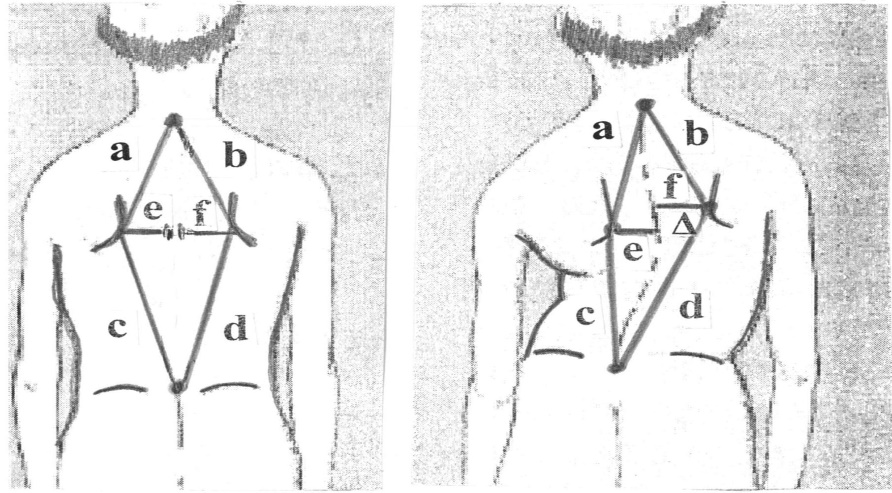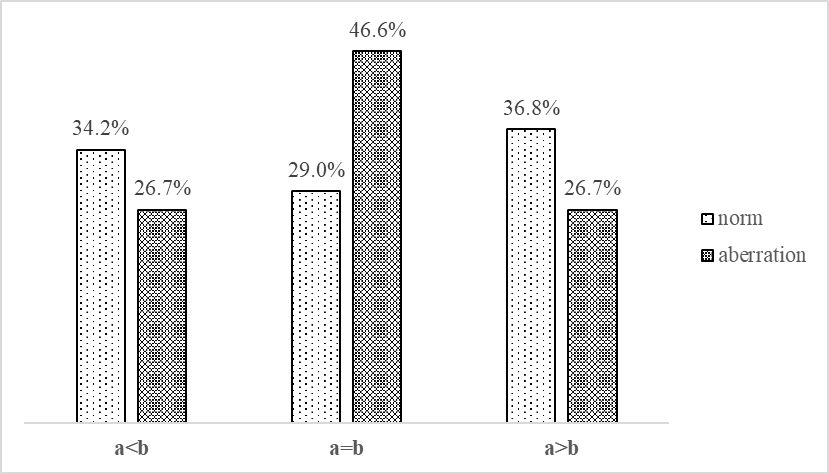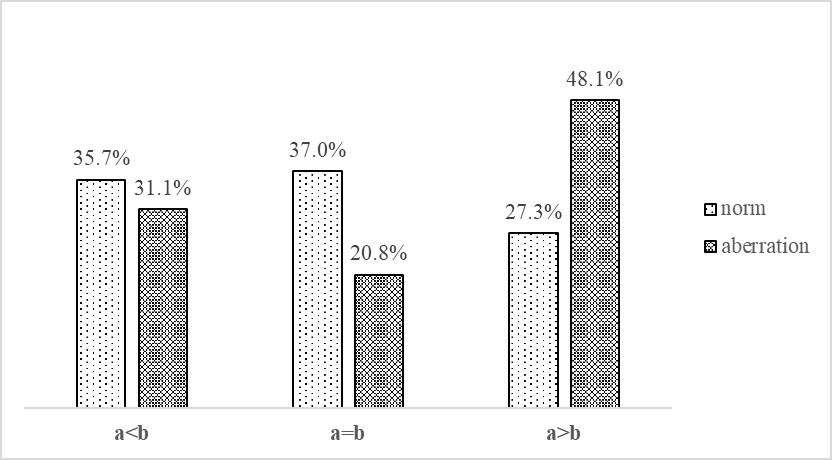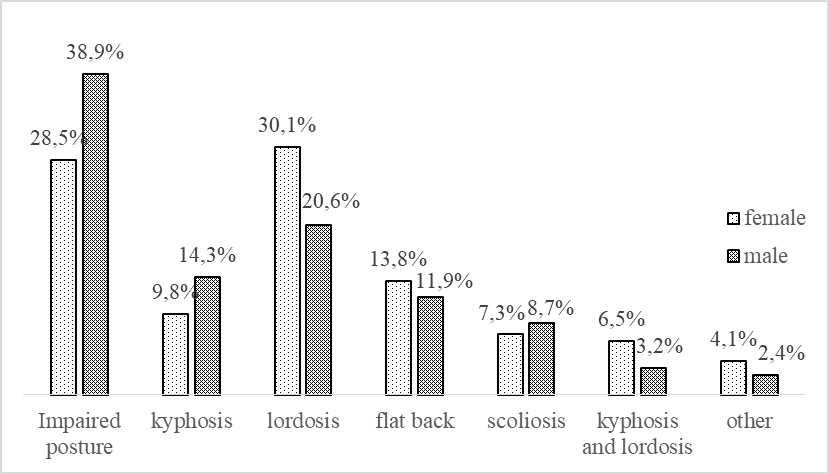Abstract
Motor activity for children with vertebral distortions is a major factor in general strengthening, proper development and stimulation of the whole organism. This helps to overcome spinal problems, improve the function of the lungs and the chest and create a strong muscle corset. The aim of the present study is to diagnose spinal deformities and to extend the professional competences of the students of specialty "Medical rehabilitation and ergotherapy" for work with children. The subject of the study is 248 children aged 6 and 7 from the kindergartens on the territory of the town of Stara Zagora during the clinical practice of the students. The analysis of the most common types of spinal deformities was the basis for compiling and conducting a program to increase the motor activity of children. Through a motor activity, swimming and sports games, the tone of the spinal muscles is improved, the muscle imbalance is overcome and the movement of the chest is stimulated. A healthy muscular corset is created and the neuropsychological development of the children is stimulated. Involvement of students in preventive actions to combat vertebral distortions is an innovative approach to practical training that stimulates motivation and improves practical skills.
Keywords: Motor activityearly diagnosticsspinal deformities
Introduction
Several authors point to six major factors determining the anomalies of growth and deformities of the spinal cord and thorax. These are: the genetic factors affecting the growth and development of the locomotory system; hormonal and metabolic dysfunctions affecting calcium-phosphate metabolism; biomechanical factors due to decreased motor activity; environmental factors and lifestyle related to children's eating habits; abnormal skeletal growth and congenital abnormalities associated with the nervous system. Modern NMR studies of children with vertebral distortions confirm this thesis (Zadeh & Gleiber, 2015; Chu, Rasalkar, & Chen, 2011; Woggon & Martinez, 2013).
Signs of scoliosis begin in early childhood, may develop during growth and become permanent if not treated. These occur in children aged 5 to 6 years, but the spinal curve is labile, decreasing in the pelvic position and corrected for mobilization of the musculature (Filkova, 2013, 2017). A thorough postural evaluation is required to check if the problems are related to lower limbs, pelvis, shoulder belt, torso, upper limbs, or functional reasons only. A thorough postural evaluation is required to check if the problems are related to lower limbs, pelvis, shoulder belt, torso, upper limbs, or functional reasons only (Vieira et al., 2015; Vacheva, 2013).
The poor posture is characterized by the weakness of the whole body, especially the muscular system, a disturbance of the static position of the spine and other parts of the locomotory system (Pfeiffer, Kotz, Ledl, Hauser, & Sluga, 2006). The motor and sensor systems involved in the posture stability pass through a transition period of 4-6 years to maturity at the age of 7-10 years. Rapid growth from childhood to adolescence occurs at the age of 9-12 and can cause enormous changes in the position, shape and size of the spine, muscular strength and flexibility that affect postural instability (Konieczny, Senyurt, & Krauspe, 2013; Melo et al., 2017).
The basic principles defining the correct approach to correcting the disturbed posture and overcoming the spinal deformities are limited to: maintaining the motor activity of all the structures of the spine - intervertebral discs, joints, ligament apparatus and muscles; overcoming muscle imbalance because hypertonic muscles hamper flexibility and hypotonicity of spine stability; overcoming ligament abnormalities associated with bone growth and stimulation of postural control, nervous system and equilibrium reactions (Paskaleva, 2012; Ilieva & Paskaleva, 2010; Platikanova, 2015).
The poor posture is characterized by the weakness of the whole body, especially the muscular system, a disturbance of the static position of the spine and other parts of the locomotory system (Pfeiffer et al., 2006). The motor and sensor systems involved in the posture stability pass through a transition period of 4-6 years to maturity at the age of 7-10 years. Rapid growth from childhood to adolescence occurs at the age of 9-12 and can cause enormous changes in the position, shape and size of the spine, muscular strength and flexibility that affect postural instability (Konieczny et al., 2013; Melo et al., 2017).
Spinal deformities are among the most prevalent diseases in childhood and adolescence. Contemporary lifestyle and reduced motor activity are factors that provoke the appearance of irregular posture and various deformities of the spine and thorax in preschool children. The physical development of children and adolescents correlates with their motor and diet regime, with their constitution, with the hardening, early detection, prophylaxis and treatment of the acute and chronic diseases accompanying the growth (Koleva, 2009; Koleva, 2010). A thorough postural evaluation is required to check if the problems are related to lower limbs, pelvis, shoulder belt, torso, upper limbs, or functional reasons only (Bogdanović, Mavrić, & Mavrić, 2017; Chiwaridzo & Naidoo, 2016).
Problem Statement
Early diagnostics, systemic monitoring, treatment, and the actual motor regimen contribute to the favorable outcome of disturbed preschool posture in children (Mollova & Uzunova, 2017; Platikanova, Karabayeva & Naneva, 2015). Of particular importance is the good organization of healing and healing measures including a timely diagnosis to prevent gross spinal and thoracic deformities with subsequent complications leading to severe disability (Рaskalevа, 2015; Platikanova, & Karabayeva, 2015).
Research Questions
The presence of symmetry of the body is evidence of a perfect posture. The presence of asymmetry results in a spine deviation in the frontal plane and is evidence of scoliosis - lateral spine distortion.
Purpose of the Study
The aim of the present study is to study the physical development of pre-school children aged 5-6 and to define the factors leading to the spinal distortion and impaired posture.
Research Methods
The subject of the study is 248 children aged 6 and 7 from the kindergartens on the territory of the town of Stara Zagora during the clinical practice of the students.
The analysis of the most common types of vertebral distortions was the basis for compiling and conducting a kinesitherapeutic program to increase the motor activity of children
Methodology of the study. Before the diagnosis, children were selected by tracking physical development and observation from behind, from the side and in the front. Of the 1,200 examined children aged 6-7, targeted for measurement were 248 children. For this purpose, a special map for child-related diagnosis is compiled. Measurements and studies of the spine and thorax were performed by measuring the mobility of the cervical spine, and the tests of Ot, Tom Mair, Schober, Moshkov’s quadrangle, chest circumference (X1, X2, and X3) and manual-muscular test for abdominal, dorsal and sedative muscles, Chinzin's planogram. Written informed consent of the parents for the participation of the children in the rehabilitation events was made. Measurements and studies are reported in a special diagnostic card for each child.
The statistical analysis was performed using SPSS version 16.0 (SPSS Inc., Chicago, IL). Quantitative data were presented as average and standard deviation if they were normally distributed or otherwise median and range. They were compared to the Man-Whitney rank test. Normality is assessed by the Kolmogorov-Smirnoff test. Accurate data were analysed by Fisher's exact test. Cramer's V was used as a post-test to determine the strengths of association after the exact Fisher test that determined the significance. A value of the 2nd p <0.05 is considered significant.
Findings
Of the 248 children surveyed, only 75 children (30%) had no asymmetry of the blades at Moshkov's quadrangle. This corresponds to the studies of Figure

When testing the vertebral distortion by the Moshkov’s quadrangle from a posture stand with a denture pencil, the points of the spines of the vertebrae C7 and L5, as well as the lower medial corners of the blades. The sides of the thus formed quadrangle at the normal position of the body are symmetrical to the spine, i. E. the left part of the quadrangle is symmetrical on the right-hand side of the quadrangle. In the presence of spinal distortion symmetry is distorted to varying degrees. This method is particularly well suited to measuring various disorder disturbances of children aged 5-6. The presence of symmetry of the body is evidence of a perfect posture. The presence of asymmetry results in a spine deviation in the frontal plane and is evidence of scoliosis - lateral spine distortion (Paskaleva, 2012; Рaskalevа, 2015).

There is no statistic relationship between a b and the disordered posture (Figure

In Figure

Depending on the type of distortion, the results of the study (Figure
Early diagnostics, systemic monitoring, treatment, and the actual motor regimen contribute to the favorable outcome of disturbed preschool posture in children (Mollova, Uzunova, Popov, & Milcheva 2017; Platikanova, Karabayeva, & Naneva, 2015). Of particular importance are the good organization of healing and healing measures including a timely diagnosis to prevent gross spinal and thoracic deformities with subsequent complications leading to severe disability (Platikanova & Karabayeva, 2015; Рaskalevа, 2015).
Conclusion
Considering the widespread prevalence of vertebral distortions at preschool age in children aged 6 and 7 years there is a need for regular and systematic participation in prevention programs for the diagnosis and prevention of vertebral distortions carried out annually in order to prevent later onset orthostatic disorders. There is a need for continuous cooperation between kindergarten teachers and the public to increase the participation of children involved in various forms of sport, recreation and various types of motor activities.
There is a need for systemic kinesitherapy, swimming and sports games to improve back muscular tone, overcome muscle imbalance and stimulate chest mobility. This creates a healthy muscular corset, stimulates the nerve-psychological development of the children and prevents the increased spinal deformities.
References
- Bogdanović, Z., Mavrić, F., & Mavrić, A. (2017). Effects of a Programmed Corrective Training on Postural Disorders in Lumbar and Thoracic Region. International Journal of Sports and Physical Education (IJSPE), 3(1), 7-1.3 DOI:
- Chiwaridzo, M., & Naidoo, N. (2016). Functional consequences and health-care seeking behaviour for recurrent non-specific low back pain in Zimbabwean adolescents: a cross-sectional study. European Spine Journal, 25(2), 643–650. DOI: 10.1007/s00586-015-4105-9
- Chu, W. C., Rasalkar, D. D., & Cheng, J. C. (2011). Asynchronous neuro-osseous growth in adolescent idiopathic scoliosis-MRI-based research. Pediatr Radiol, 41(9), 1100–1111. DOI:
- Filkova, S. (2013). Methodic for the prevention of vertebral distortions in preschool children. Paper presented at the International Scientific Conference "European Standards in Sport Education", Vratsa, Bulgaria.
- Filkova, S. (2017). Prophylaxis of spinal distortion in pre-school children. (Doctoral dissertation).
- Ilieva, I., & Paskaleva, R. (2010). Physical activity motivating effect of kinesitherapy in school settings. Student Team Practice for the Prevention of Metabolic Syndrome (pp. 108-111). Stara Zagora, Bulgaria: Academic Publishing House.
- Koleva, I. (2009). Short Course on Kinesitherapy (for rehabilitators): Textbook for rehabilitators from the first year of Medical College at Medical University. (2nd Complete and Revised Edition). Sofia, Bulgaria: RIM "SIMEL".
- Koleva, I. (2010). Fundamentals of rehabilitation (with algorithms for socially significant diseases and damage to the nervous system and the locomotor system), Textbook. Sofia, Bulgaria: RIM "SIMEL".
- Konieczny, M. R., Senyurt, H., & Krauspe, R. (2013). Epidemiology of adolescent idiopathic scoliosis. J Child Orthop, 7(1), 3–9. DOI:
- Melo, K., de Barros, S. B., Santos, T., De Marco, A., Hirota, V., & de Sa, C. A. (2017). The Relationship between Family Lifestyle and Physical Activity of Children from 4 to 6 Years. International Journal of Sports and Physical Education (IJSPE), 3(4), 12-16. DOI:
- Mollova, K., & Uzunova, A. (2017). Flat feet - a neglected problem with significant consequences. KNOWLEDGE International Journal Scientific Papers, 16(4), 1564-1570.
- Mollova, K., Uzunova, A., Popov, I., & Milcheva, Hr. (2017). Analysis of screening results for postural distortion and flatness in children in first to fourth grade. Management and Education, 13(5), 106-110.
- Paskaleva, R. (2012). Innovative Elements in the Kinesitherapy Training, Art Therapy and Ergotherapy for Students Rehabilitators, Monograph. Gabrovo, Bulgaria: Publishing House EKS-PRESS.
- Paskaleva, R. (2015). Kinesitherapy in common diseases in childhood and relaxation techniques. Textbook. Gabrovo, Bulgaria: Publishing House EKS-PRESS.
- Pfeiffer, M., Kotz, R., Ledl, T., Hauser, G., & Sluga, M. (2006). Prevalence of Flat Foot in Preschool Aged Children. Pediatrics, 118(2), 634-639. DOI:
- Platikanova, M. (2015). Illness in children and students from Stara Zagora region. Varna Medical Forum, 4(3), 252-256.
- Platikanova, M., & Karabayeva, V. (2015). Some indicators for physical development of children and students from Stara Zagora region. Varna Medical Forum, 4(3), 257-261.
- Platikanova, M., Karabayeva, V., & Naneva, S. (2015). The state of the sports facilities in the schools in Stara Zagora - a prerequisite for good health. Varna Medical Forum, 4(3), 262-266.
- Vacheva, D. (2013). Rehabilitation and Occupational Therapy in Some Common Motor Deficits. Saarbrucken: LAP LAMBERT Academic Publishing.
- Vieira, D. B. A. L. P., Beresoski, C. M., Camargo, M. Z., Fernandes, K. B. P., Siqueira, C. P. C. M., & Fujisawa, D. S. (2015). Early signs of scoliosis in preschool children. Fisioter Pesquisa, 22(1), 69-75. DOI: 10.590/1809-2950/13269222012015
- Woggon, А., & Martinez, D. (2013). Chiropractic treatment of idiopathic scoliosis with the CLEAR Institute method: a description of the protocol. Scoliosis; 8(2). DOI:
- Zadeh, J. R., & Gleiber, M. A. (2015). Adolescent Idiopathic Scoliosis: An in Depth Analysis and Historical Review. MOJ Orthop Rheumatol, 3(4), 00105. DOI:
Copyright information

This work is licensed under a Creative Commons Attribution-NonCommercial-NoDerivatives 4.0 International License.
About this article
Publication Date
16 May 2019
Article Doi
eBook ISBN
978-1-80296-060-0
Publisher
Future Academy
Volume
61
Print ISBN (optional)
-
Edition Number
1st Edition
Pages
1-87
Subjects
Sports, sport science, physical education
Cite this article as:
Paskaleva, R., Ivanova, V., & Pavlova, V. (2019). Motor Activity For Spinal Deformities In Children Of Pre-School Age. In E. Lupu, G. Niculescu, & E. Sabău (Eds.), Sport, Education and Psychology - icSEP 2019, vol 61. European Proceedings of Social and Behavioural Sciences (pp. 80-87). Future Academy. https://doi.org/10.15405/epsbs.2019.05.9

